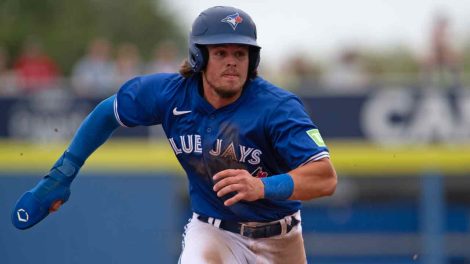This story originally appeared in the March 24, 2014 issue of Sportsnet magazine.
Scott Boras still remembers the first time he heard about Bryce Harper. It was 2007 and the veteran agent got a call from Kurt Stillwell, a former MLB all-star who was on a scouting mission for the Boras Corporation in Las Vegas. Stillwell gave his boss an order: “I need you to come over here this weekend,” Stillwell told him, explaining that he’d just watched Harper play. “But before you come I want to tell you something. He’s 14.”
“You want me to come watch a 14-year-old player?” Boras replied.
But Stillwell isn’t prone to hyperbole, and Boras made the trip to Vegas to see the prospect with his own eyes. Right away he knew his scout was onto something special. Boras was right. Since that day, Harper’s ascent to stardom has been as publicly scrutinized as it has been rapid. On the cover of Sports Illustrated at age 16, Harper was a two-time all-star with 42 career home runs before he could legally buy a drink. Playing against older competition became the norm for Harper, who has been the youngest player in the National League for every single inning of his two-year MLB career. “Remember when you’re talking about a great, young player playing against older competition, usually you’re talking about two or three years,” says Boras, who has represented Harper for his entire professional career. “In the major leagues [for Harper], it’s 15 years.”
That’s why the 21-year-old belongs in every discussion about the game’s best young talents, alongside L.A. Angels outfielder Mike Trout, who’s more than a year older. “This is an oxymoron, but they’re both once-in-a-generation players,” says one longtime scout. “They just happened to come up basically at the same time.”
The way MLB scouts see it, Harper’s already an impact player, and he’s only getting better. Within a few seasons, they expect his skills will allow him to hit .300 with 35 or 40 home runs, while showing off above-average speed and a big arm—it’s that exceptional ability that makes Harper’s Nationals Sportsnet’s World Series pick.
To better understand Harper’s skill set and where it can take him, here’s a close look at five plays from the 2013 season from the perspective of those same scouts. With the moments below as a guide, scouts helped generate a skill-by-skill breakdown of Harper’s five tools.
THE SCOUTING SCALE
MLB scouts use the 20–80 scale to evaluate major leaguers, where 80 is outstanding and extremely rare, 50 is average and 20 is poor. For example, Miami’s Giancarlo Stanton has 80 power, and L.A. Dodger Clayton Kershaw has an 80 curveball. On the other end of the spectrum, Boston’s David Ortiz has 20 speed, and Philadelphia’s Ben Revere has 20 power.
Throwing
Scouting grade: 70
The play (Aug. 3) Harper’s playing left field when Brewers utility man Yuniesky Betancourt lines a hit past third. By the time Harper reaches the ball he’s almost in the corner and Betancourt has rounded first with his sights set on a double. Harper plants his back foot and winds up, rotating his torso away from the seats and toward the infield. He uncorks a rocket that reaches second baseman Anthony Rendon on the fly. There will be no two-bagger for Betancourt, who’s still 10 feet from the base when the ball arrives.
Harper was clocked throwing 96 mph as a teenager, and was on track to make a career of gunning down baserunners from behind home plate until moving from catcher to the outfield when the Nationals drafted him first overall in 2010.
Harper now has one of the best outfield arms in the National League (one scout referred to his arm as an “absolute cannon”), ranked alongside Arizona’s Gerardo Parra and L.A. Dodger Yasiel Puig. But there’s more to it than that. “You see guys like Puig, who has great strength without the accuracy, but Harper has both,” an NL scout says.
Some scouts have seen a slight dropoff in Harper’s throwing power since he was drafted in 2010. Those decreases are common for players as they age and their arms accumulate wear and tear, and it’s not something that will limit his ability on the field any time soon. Scouts expect to see Harper keep gunning runners down frequently—as long as they don’t stop challenging him altogether.
Fielding
Scouting grade: 60
The play (Aug. 23) The Kansas City Royals have the tying run on first base with the Nationals leading by one in the bottom of the ninth. Emilio Bonifacio skies a fly ball to shallow right field where Harper pauses momentarily before sprinting in 50 feet. He then dives and catches the ball backhanded while fully extended before tumbling along the Kauffman Stadium grass, forcing the runner back to first.
Scouts say most corner outfielders don’t have the athleticism to complete this diving grab. First Harper has to accelerate and use his speed to reach the shallow ball. Then he has to dive headlong and make the catch, showing off body control matched by few of his peers.
It may be the best catch Harper made in 2013, but there’s some room for improvement here. While Harper’s instincts and athleticism allow him to make difficult plays, the routes he takes aren’t always direct. “His reads are still a bit slow, and you can see that here,” one scout says.
Yet scouts say he’s still adjusting to his position. Harper has played left, centre and right at the big-league level, which means he has effectively had to learn three positions at once. Many believe bouncing around between outfield spots has made the learning process unnecessarily complex. “The hardest part is we would really like to see Bryce stick in one position,” Boras says.
Scouts believe Harper could handle centre if given the time and opportunity, but he won’t have to as long as Denard Span plays for the Nationals. That may be for the best, since many believe Harper’s strong arm and solid build make him best-suited to a corner spot long-term.
Running
Scouting grade: 60
The play (April 26) Harper pulls Homer Bailey’s pitch down the right-field line, and Cincinnati Reds right-fielder Jay Bruce has to run a long way to retrieve the ball. It’s immediately apparent Harper’s thinking extra bases. As he rounds first he gains speed but loses his batting helmet. Moments later he slides into third well before the Reds’ relay. It’s been less than 12 seconds since he first made contact.
Given the high-flying intensity on display every time he takes the field, it’s no surprise to hear multiple talent evaluators compare Harper’s playing style to that of Pete Rose. Harper’s above-average speed will allow him to turn doubles into triples, singles into doubles and steal 15 to 20 bases per season. Combine that speed with well-developed baserunning instincts and scouts are impressed. “Bryce is a good major-league baserunner because he’s just ultra-aggressive, which is what we like,” an AL scout says.
Even so, there’s some concern about his future running ability. Harper quite literally ran into a wall at Dodger Stadium last year, just one example of his trademark all-out playing style. “He plays with a little bit of recklessness,” says one MLB scout. “He might just need to tone down the running into walls.”
Another scout adds: “Baseball’s not like football. You can’t play 100 percent all the time.”
Listed at 230 lb., Harper carries a lot of muscle on his frame. “That’s a big man, so that’s going to be hard on his knees,” an NL scout says. Harper spent time on the DL with knee bursitis in 2013 and underwent off-season surgery to clean it up. If his knees are restored to full strength after an off-season of rest, he’ll be able to use his speed to his advantage in 2014. Health permitting, scouts expect Harper’s speed will continue to distinguish him as a rare power hitter who can steal a base and leg out a triple.
Hitting
Scouting grade: 70
The play (July 7) Midway through an unforgiving lefty-lefty matchup, Harper finds himself down in the count, one ball and two strikes. San Diego Padres pitcher Robbie Erlin delivers a 90-mph fastball up and away from Harper, perhaps with the intention of getting him to chase. But the pitch catches enough of the plate for Harper to make contact. He shortens his swing and hits a soft line drive the opposite way for an RBI single.
This plate appearance is a good example of why scouts believe Harper’s career average of .272 is about to rise. “He’s able to use all fields because he keeps the bat in the zone for so long,” says one scout. That helps him put the ball in play more frequently and use the entire field instead of relying on the all-or-nothing uppercut preferred by many power hitters. Plus, Harper knows to ease up in certain situations instead of always swinging for the fences. “He’s learned where he doesn’t have to apply force,” says Boras. “He’s using more technique to hit a baseball.”
Scouts believe he can hit .290 to .300 with a .400 on-base percentage once he’s fully adjusted to big-league pitching. Harper spent just 39 games at double-A and 21 games at triple-A before getting called up to the big club. He has had to make adjustments on the fly, but that hasn’t stopped him from hitting.
Already, rival scouts are dreading the prospect of trying to limit the damage Harper does in his prime. “By the time he’s 24 or 25, it’s going to be scary,” says one scout.
Power
Scouting grade: 80
The play (April 10) Holding a 1–0 lead, Chicago White Sox pitcher Gavin Floyd starts the bottom of the fourth by throwing an 86-mph cutter that stays up in the zone. Harper draws his arms back and steps into the pitch with a small leg-kick, generating exceptional bat speed as he rotates his hips toward the pitcher’s mound. There’s no doubt that this one is leaving the yard, so Harper takes a moment to admire the shot as it makes its way deep into the second deck at Nationals Park. Realizing he has no chance at making a play, right-fielder Alex Rios barely moves. Tie ball game.
We shouldn’t be surprised when Harper hits a 420-foot moonshot as he did against Floyd—he was hitting 500-foot homers as a 15-year-old. His exceptional power has been his best asset since he was a teenager, and projects as his specialty for years to come. Scouts use phrases like “amazing raw strength,” “incredible bat speed” and “lights-out power” to describe Harper. They say he has 40–home run potential thanks to a swing that keeps the barrel of the bat in the zone long enough to deliver blasts to all fields.
The power that Boras and Stillwell saw seven years ago has begun translating to the MLB level at an age when most players are still in college. If Harper’s swing and strength are any indication, those power numbers are only going to become more impressive with time. With so many accomplishments at such a young age, many call Harper a boy wonder. Boras, however, disagrees with that characterization vehemently, insisting on this: Bryce Harper is a man. “His body now is toned, in shape,” Boras says. “He has an opportunity, I think, to become one of the pre-eminent sluggers of his generation.”
Boras may be prone to making bold statements, particularly about his own clients, but on the subject of Bryce Harper’s potential, scouts couldn’t agree more.










